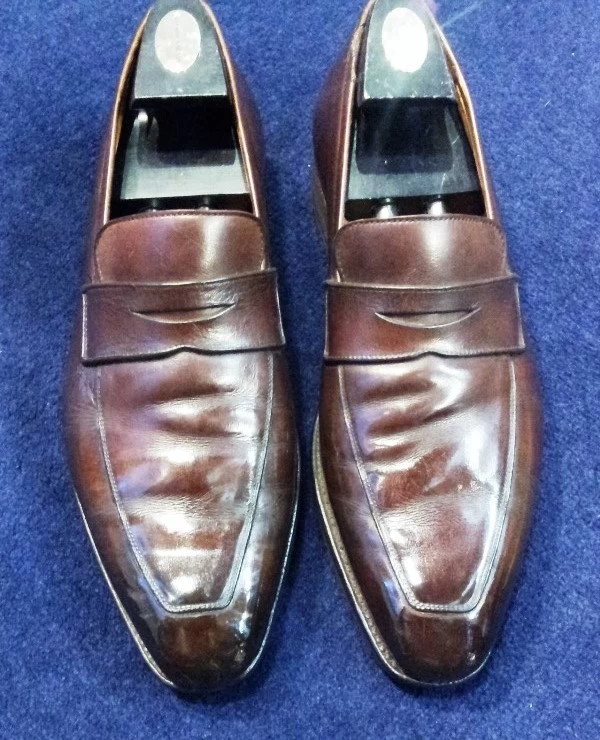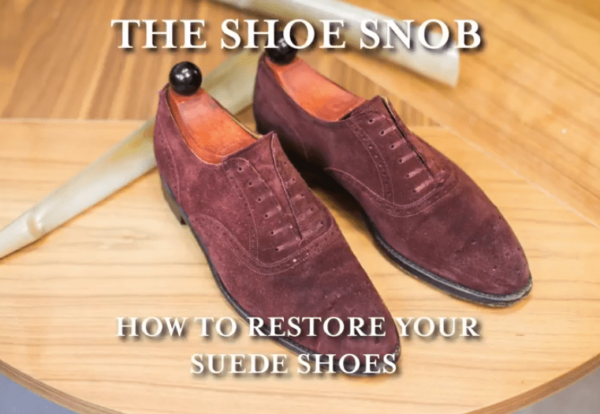This post will seem trivial to many but the reality is that it is not trivial to most if you do some Googling and/or have direct contact with a lot of shoe consumers. The reality is that a lot of people are constantly over conditioning their shoes and doing so is one of the worst things you can do for your fine leather dress shoes. This post is not about how to fix the issue but rather how to prevent it. And again, many of you (especially if you have read this blog longer than a month) will know these truths but in the hopes of consistently battling the bad info out there on the shoe side of the web, I must put these words into the sphere in hopes that the algorithm helps to reach the overzealous shoe care enthusiasts.

Right now, Americana-style boots (think Red Wing, Thursday Boots, Viberg etc) are all the rage in the US. And because of that, you have a million and one videos about their care. The problem is caring for the leather often used on those types of footwear is vastly different than caring for your fine leather dress shoes. And because of the amount of info out there, the bombardment of it in fact, I often feel that people apply a one size fits all method to shoe care after grouping together the number of videos they have watched by non-experts. Most people simply want to whack on conditioner as if the dress shoes just went through the Sahara and back. But it’s not sunblock. It doesn’t need to be doused on. And the issue is that the reality couldn’t be further from their idea about what the shoes need. Most shoes made with good leather are actually quite resilient and really don’t need as much care as we are often told.


I have always hated the question “how often should I condition?” I mean, how long is a piece of string? There is no right answer. There is no ‘one’ answer. You will hear people pull figures out of their butt and say ‘after 5-10 wears.’ Oh yeah? But 5-10 wears could be a night-and-day difference for two different people. Imagine one lives in Manhattan and walks to work. He can experience extreme heat/humidity, rain, puddles, snow, salt, slush etc. His 5-10 wears are completely different than someone that lives in Suburban America, goes from his house garage to his work garage, a heat-regulated work environment, and back again, and never sees any real pavement or adverse weather conditions. That person doesn’t need to condition after 5-10 wears. I ask myself, how do people not see this? It really is just common sense. But I guess we all know that it is really not that common anymore. The web of information has significantly dumbed us down to simply look for our answers instead of trying to figure them out. And through this fear of going through the trial and error way of learning (the best way), we often take bad advice and do more damage.

So you might ask, ‘well, why should we listen to you?’ Well, the reality is that I have shined thousands and thousands of shoes in my life of all types and of all brands. And I have messed some up and learned the hard way. But more important than that is because I loathe hearing people whining online about how they messed up their shoes and somehow blame the shoe manufacturer and/or the shoe care company. So many have complained about renovator and the reality is that they never knew how to use it and thus did their own damage. I used it for years and it worked like a dream. But that is because I stuck to point 4 below. So having read countless blunders online I will do anything to try and educate people into taking responsibility for their own shoe care mishaps. Call it a tall order but here we are on my 100th shoe care post.
So, how do we prevent it? Well, let’s look at a few things to help:
1. First and foremost, try to figure out what type of leather your shoes are. Ask the manufacturer if you are not sure. If they are box calf, they will be more resilient to shoe care products. Box calf is made with one of the deepest methods of dyeing the leather in order to get that strong uniform color that stands the test of time. Some ways to figure this out is knowing is simply by observing if your shoes are a strong uniform color or have variations in their coloring. Most shoes that looked aged, patina’d etc are made from crust leather. And crust leather is one of the most reactive to any type of lubricant/liquid.

2. If they are box calf, chances are you can condition away as you like, but always bear in mind that you need not overapply. Droplets are your friend. The darker the color, the safer you are. But any leather can be oversoaked so always maintain the droplet rule. And test the leather by starting at the inside heel area. If no adverse reaction in color then feel free to condition away, working in a little and spreading evenly. If they are crust, well, the same process applies, but use even less conditioner. Note, that many crust shoes will immediately darken but dry afterward. Sometimes though, the initial contact will leave a small stain, especially if too much was applied. The way to prevent this is, again by using less, and two, by rubbing it in very quickly, spreading it around as much as you can so that not too much sits in one spot. It’s like rain, if your shoes get soaked, they dry evenly. If one droplet hits your leather and is allowed to absorb into it and thus never gets wiped off, that droplet can leave a stain. Same concept with conditioner except is more dangerous than rain if not used properly.
3. If you are unsure then simply do not use conditioner. Use a neutral cream polish that also has its own rejuvenating qualities without all of the greasy qualities that conditioner has. Using a conditioner is really only needed when your leather is super dry. Or if you have just stripped it with stripping agents. Or if like 6 months have passed and you have just been caking on wax the whole time. It is not a weekly regimen or even monthly unless you only have a 3 pair rotation. If you have 5 pairs or more and rotate accordingly, using conditioner is not needed as much as you might think. Again, there is no right or wrong answer. But the fact is, over-conditioning also has its own issues. Feel your leather. More often than not it just needs a brush down and some cream polish.

4. I cannot stress enough the rule of droplets. Never use a brush to apply conditioner. Use a cotton rag and only dab a small amount on. Work it in and see how the leather absorbs. If the leather is super dry, you can apply more. If it is not, then it simply is not necessary. Caking it on only creates worse issues.

5. Avoid it on new shoes. We all know how much I stress this because chances are your new shoes have already been treated and thus you are adding unnecessary care to them. If your new shoes are old, used shoes, then knock yourself out. But if they come from well-respected shoemakers, well the reality is shoe care is a part of the finishing stage of shoe production so it has already been creamed.
I know many of you will all know this stuff, but chances are someone you know doesn’t. Feel free to spread this info. As always, remember the motto: A little goes a long way!













I was stupid to condition my GG Margaux out of the box, because saphir renouvator was extremely harsh and it peeled of the patina.
I was advised my others on instagram to avoid conditioners on patina shoe, rather use neutral cream which has properties of the conditioner with out being harsh while give you the soft shine you desire.
That’s rough to learn on a G&G but often the best way to learn is the hard way. Hopefully you managed to get it fixed